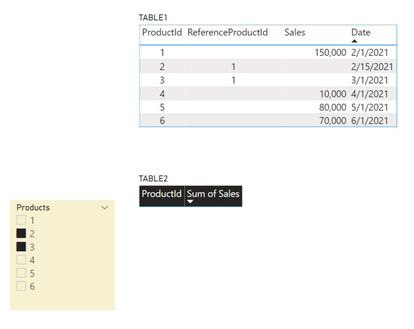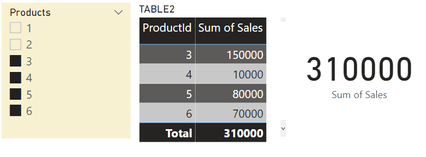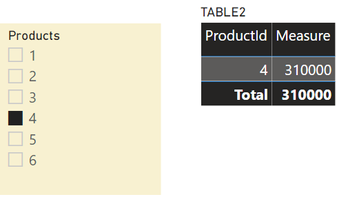FabCon is coming to Atlanta
Join us at FabCon Atlanta from March 16 - 20, 2026, for the ultimate Fabric, Power BI, AI and SQL community-led event. Save $200 with code FABCOMM.
Register now!- Power BI forums
- Get Help with Power BI
- Desktop
- Service
- Report Server
- Power Query
- Mobile Apps
- Developer
- DAX Commands and Tips
- Custom Visuals Development Discussion
- Health and Life Sciences
- Power BI Spanish forums
- Translated Spanish Desktop
- Training and Consulting
- Instructor Led Training
- Dashboard in a Day for Women, by Women
- Galleries
- Data Stories Gallery
- Themes Gallery
- Contests Gallery
- Quick Measures Gallery
- Notebook Gallery
- Translytical Task Flow Gallery
- TMDL Gallery
- R Script Showcase
- Webinars and Video Gallery
- Ideas
- Custom Visuals Ideas (read-only)
- Issues
- Issues
- Events
- Upcoming Events
Calling all Data Engineers! Fabric Data Engineer (Exam DP-700) live sessions are back! Starting October 16th. Sign up.
- Power BI forums
- Forums
- Get Help with Power BI
- Desktop
- Re: How to sum values basing on a slicer (column1)...
- Subscribe to RSS Feed
- Mark Topic as New
- Mark Topic as Read
- Float this Topic for Current User
- Bookmark
- Subscribe
- Printer Friendly Page
- Mark as New
- Bookmark
- Subscribe
- Mute
- Subscribe to RSS Feed
- Permalink
- Report Inappropriate Content
How to sum values basing on a slicer (column1) and a reference or group ID (another column2)?
Hi everyone!
I have a sample Power BI test data / scenario in the following link: https://drive.google.com/file/d/1EGEfkwvkozr7FnuTfGWR9tcZKSPk5hT5/view?usp=sharing
What I want to achieve is upon selecting the productId on the slicer on the left (in the above image), it will get the shared sales where when ReferenceGroupId is not blank, it will get/use the sales from the referenced product. For instance, if I select Products 2 and 3, I want that the sum of sales in TABLE2 would show as below:
ProductId | Sum of Sales
2 | 150,000
3 | 150,000
And when I select all products in the slicer (2~6), I want to get the total value of 310,000 with sales of products 2 to 3 only getting a sum of 150,000 even without selecting product 1 (since it is a shared sales value) and be able to show it in a Card Visual.
The problem seems to be a bit simple, but I have already spent few hours trying to address it. Any direction or clue on how to solve this will be much appreciated. Thank you!
Solved! Go to Solution.
- Mark as New
- Bookmark
- Subscribe
- Mute
- Subscribe to RSS Feed
- Permalink
- Report Inappropriate Content
Hi @iamriz ,
Here are the steps you can follow:
1. Create measure.
Measure =
var _select=SELECTEDVALUE('SalesInfo'[ProductId])
var _sum=CALCULATE(SUM('SalesInfo'[Sales]),FILTER(ALL('SalesInfo'),'SalesInfo'[ProductId]<_select))
var _rp=CALCULATE(SUM('SalesInfo'[ReferenceProductId]),FILTER(ALL('SalesInfo'),'SalesInfo'[ProductId] = _select))
return
IF(
_rp <> BLANK(), _sum,CALCULATE(SUM('SalesInfo'[Sales]),FILTER(ALL('SalesInfo'),'SalesInfo'[ProductId] = _select))
)Sum of Sales =
VAR __table = SUMMARIZE('SalesInfo',[ProductId],"__value",[Measure])
var _productid=SELECTCOLUMNS('SalesInfo',"1",[ProductId])
RETURN
IF(HASONEVALUE('SalesInfo'[ProductId]),[Measure],
SWITCH(
TRUE(),
1 in _productid||2 in _productid||3 in _productid,
SUMX(FILTER(ALL('SalesInfo'),'SalesInfo'[ProductId]=1),'SalesInfo'[Sales])+SUMX(FILTER(__table,NOT([ProductId] in {1,2,3})),[__value]),
SUMX(__table,[__value])))2. Result:
Choose 3, 4, 5, 6, and the result is:
Choose 1, 2, 3, 4, 5, 6, and the result is:
Choose 1, 2, 3, the result is:
Does this match your expected result.
Best Regards,
Liu Yang
If this post helps, then please consider Accept it as the solution to help the other members find it more quickly.
- Mark as New
- Bookmark
- Subscribe
- Mute
- Subscribe to RSS Feed
- Permalink
- Report Inappropriate Content
Hi @iamriz ,
Here are the steps you can follow:
1. Create measure.
Measure =
var _select=SELECTEDVALUE('SalesInfo'[ProductId])
var _sum=CALCULATE(SUM('SalesInfo'[Sales]),FILTER(ALL('SalesInfo'),'SalesInfo'[ProductId]<_select))
var _rp=CALCULATE(SUM('SalesInfo'[ReferenceProductId]),FILTER(ALL('SalesInfo'),'SalesInfo'[ProductId] = _select))
return
IF(
_rp <> BLANK(), _sum,CALCULATE(SUM('SalesInfo'[Sales]),FILTER(ALL('SalesInfo'),'SalesInfo'[ProductId] = _select))
)Sum of Sales =
VAR __table = SUMMARIZE('SalesInfo',[ProductId],"__value",[Measure])
var _productid=SELECTCOLUMNS('SalesInfo',"1",[ProductId])
RETURN
IF(HASONEVALUE('SalesInfo'[ProductId]),[Measure],
SWITCH(
TRUE(),
1 in _productid||2 in _productid||3 in _productid,
SUMX(FILTER(ALL('SalesInfo'),'SalesInfo'[ProductId]=1),'SalesInfo'[Sales])+SUMX(FILTER(__table,NOT([ProductId] in {1,2,3})),[__value]),
SUMX(__table,[__value])))2. Result:
Choose 3, 4, 5, 6, and the result is:
Choose 1, 2, 3, 4, 5, 6, and the result is:
Choose 1, 2, 3, the result is:
Does this match your expected result.
Best Regards,
Liu Yang
If this post helps, then please consider Accept it as the solution to help the other members find it more quickly.
- Mark as New
- Bookmark
- Subscribe
- Mute
- Subscribe to RSS Feed
- Permalink
- Report Inappropriate Content
Hi @iamriz ,
Here are the steps you can follow:
1. Create measure.
Measure =
var _select=SELECTEDVALUE('SalesInfo'[ProductId])
var _sum=CALCULATE(SUM('SalesInfo'[Sales]),FILTER(ALL('SalesInfo'),'SalesInfo'[ProductId]<_select))
var _rp=CALCULATE(SUM('SalesInfo'[ReferenceProductId]),FILTER(ALL('SalesInfo'),'SalesInfo'[ProductId] = _select))
return
IF(
_rp <> BLANK(), _sum,CALCULATE(SUM('SalesInfo'[Sales]),FILTER(ALL('SalesInfo'),'SalesInfo'[ProductId] = _select))
)Sum of Sales =
VAR __table = SUMMARIZE('SalesInfo',[ProductId],"__value",[Measure])
RETURN
IF(HASONEVALUE('SalesInfo'[ProductId]),[Measure],SUMX(__table,[__value]))2. Result:
Select 4, 5, 6, and 160,000 will be displayed:
Choose 3, 4, 5, 6 products, then 310,000 will be displayed:
Best Regards,
Liu Yang
If this post helps, then please consider Accept it as the solution to help the other members find it more quickly
- Mark as New
- Bookmark
- Subscribe
- Mute
- Subscribe to RSS Feed
- Permalink
- Report Inappropriate Content
Hi @Anonymous , thanks for your help. But, choosing 3, 4, 5, 6 products should display 310,000 on the card visual. In the same way that choosing 1,2,3,4,5,6 products should also display 310,000. Since products 1,2,3 has a combined sales of 150,000. Selecting one or more among 1,2,3 products on the slicer should only have a max sales of 150,000.
- Mark as New
- Bookmark
- Subscribe
- Mute
- Subscribe to RSS Feed
- Permalink
- Report Inappropriate Content
Hi @iamriz ,
Here are the steps you can follow:
1. Create measure.
Measure =
var _select=SELECTEDVALUE('SalesInfo'[ProductId])
var _sum=CALCULATE(SUM('SalesInfo'[Sales]),FILTER(ALL('SalesInfo'),'SalesInfo'[ProductId]<_select))
var _rp=CALCULATE(SUM('SalesInfo'[ReferenceProductId]),FILTER(ALL('SalesInfo'),'SalesInfo'[ProductId]=_select))
return
IF(
_rp <> BLANK(), _sum,SUMX(ALL('SalesInfo'),'SalesInfo'[Sales])
)2. Result:
When the slicer is 2, 3, the result is:
When the slicer is another value, the result is:
Best Regards,
Liu Yang
If this post helps, then please consider Accept it as the solution to help the other members find it more quickly
- Mark as New
- Bookmark
- Subscribe
- Mute
- Subscribe to RSS Feed
- Permalink
- Report Inappropriate Content
Hi @Anonymous , thanks for your response. Greatly appreciate it. There is a problem left with your suggested solution. Even if I only select, 4,5,6 products on the slicer, the total is still 310,000 if I show "Measure" on a Card Visual. I wanted that 160,000 will be showed if only 4,5,6 is selected. Then, if 3~6 products are selected, then 310,000 will show. Kindly advise, thank you!
Helpful resources

FabCon Global Hackathon
Join the Fabric FabCon Global Hackathon—running virtually through Nov 3. Open to all skill levels. $10,000 in prizes!

Power BI Monthly Update - September 2025
Check out the September 2025 Power BI update to learn about new features.









